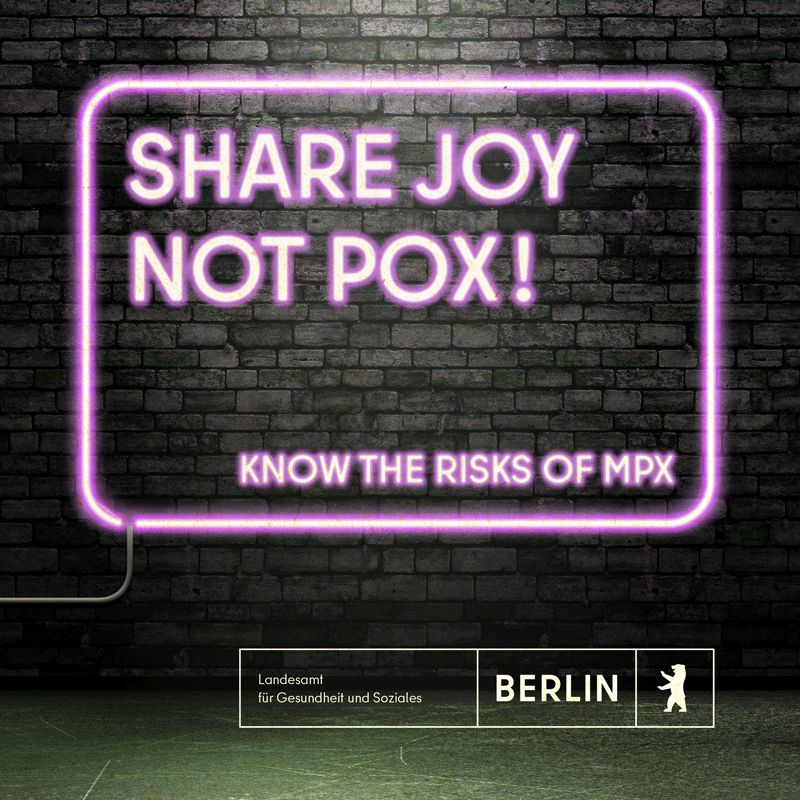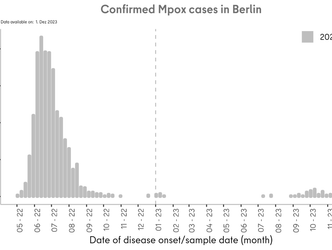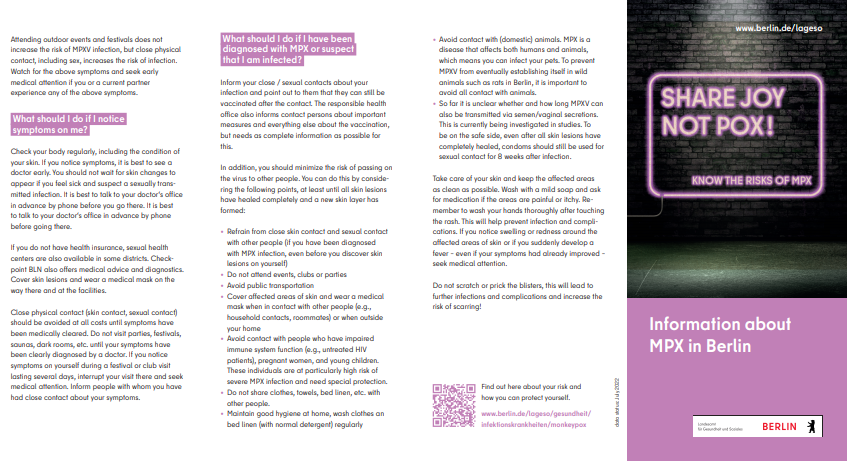Please note
The information on Mpox symptoms, incubation periods and transmission routes is subject to continuous updating. The information presented here will be adapted as new findings become available.
The information on Mpox symptoms, incubation periods and transmission routes is subject to continuous updating. The information presented here will be adapted as new findings become available.

Ad | Grafik: MPX-Kampagne
Image: LAGeSo
Mpox is a viral disease caused by the monkeypox virus (MPXV). The virus is related to the classic smallpox viruses (Variola, Smallpox). Mpox has been a rare disease in Europe, presumably transmitted to humans primarily from rodents and circulating mainly in Central and West African countries. Human-to-human transmission occurs mainly through close contact.
There are two genetically distinct lineages of the Mpox virus: clade I and clade II. Infections caused by clade I viruses are associated with more severe clinical symptoms and a higher mortality rate.
In 2022, an Mpox clade II outbreak occurred in Europe and globally where the disease was transmitted between humans through mainly sexual contact.
Although both clades have been circulating in various African countries since the end of 2023, the Democratic Republic of Congo is currently affected by a major outbreak of clade I Mpox, which has recently spread to other neighbouring African countries (Burundi, Rwanda, Uganda and Kenya). In the meantime, a first case of clade I Mpox has also been diagnosed in a traveller returning from Africa in Europe (Sweden).
The overall risk for the EU/EEA general population is currently assessed as low by the European Centre for the Prevention and Control of Infectious Diseases .
It is assumed that the vaccines available against Mpox and vaccinated in the 2022 outbreak are also effective against clade I.

Image: Lageso
As at 20.08.2024
Clade I outbreak 2023/2024
Since the end of 2023, there has been a major outbreak of clade I mpox in the Democratic Republic of the Congo, which has recently spread to other neighbouring African countries (including Burundi, Rwanda, Uganda and Kenya).
Due to the rapid rise and spread of mpcox clade I cases in the Democratic Republic of the Congo (DRC) and the recent geographical expansion to other African countries, the World Health Organization (WHO) declared a public health emergency of international concern on 14 August 2024. A day later, the first case of clade I Mpox in Europe was reported from Sweden more imported MPXV clade I cases will likely occur.
Clade II outbreak in Berlin and Europe 2022
From mid-May 2022, increased cases of Mpox were detected in several countries worldwide and a global outbreak developed, primarily affecting countries where Mpox transmission had not previously been documented. The outbreak was caused by person-to-person transmission of MPXV through close contact with infected persons. Most of the cases were men who have sex with men (MSM). This was the first time that cases and sustained chains of transmission were reported in countries without direct or immediate epidemiological links to areas in West or Central Africa.
In Europe, a total of 26,101 Mpox cases have been reported from 45 EU/EEA countries or regions via the European reporting system TESSy during the course of the outbreak so far. Worldwide, more than 100 countries have reported Mpox cases in the course of this outbreak.
Berlin was the most severely affected city in Germany. Here, a total of 1,676 Mpox cases occurred between May 2022 and January 2023. In Berlin, too, almost exclusively men were affected.
For more information on the international outbreak, please visit the ECDC and WHO websites.
Current situation in Berlin
Following the major Mpox clade II outbreak in 2022 and the subsequent broad-based vaccination campaign, only comparatively few cases of Mpox have occurred or been reported in Berlin in 2023 and 2024. So far, the infections have exclusively affected men with a median age of mid-thirties. So far, only Mpox clade II infections have occurred in Berlin.
MPXV can be transmitted through close body contact (skin-to-skin), for example during sex. Crucial here are all situations in which the viruses from affected skin areas of a sick person come into contact with the skin and mucous membrane of another person. This can also be the case when kissing, caressing or cuddling. So far, however, sexual contacts seem to play the most important role in transmission, but MPXV can also be transmitted by respiratory droplets during prolonged direct contact or by contaminated objects (e.g., clothing, bedding, and sex toys).
Transmission probably occurs mostly through direct contact with skin lesions (pimples, vesicles, scabbed pustules, crusts). However, recent studies have also shown MPXV in saliva, semen, urine, stool samples, and rectal swabs of infected individuals. Thus, MPXV can be transmitted by a variety of routes. Condoms offer protection against some, but not all, of these routes.
Investigations by the health authorities in Berlin have shown that at the beginning of the outbreak, large events such as the GayPride Maspalomas in Gran Canaria, the Darklands Festival in Antwerp or the Snax party in Berlin may have played a role in transmission. However, many cases have also been infected outside of large events/parties.
During the peak of the outbreak between May and early July, most cases became infected in Berlin, and more than half attended sex parties or clubs during their assumed infection period. However, about 20% of the cases in Berlin were also infected during stays outside of Germany, where visits to clubs or festivals were also frequently reported. Meanwhile, information regarding the possible place of infection is no longer being collated.
The time between contact with MPXV and the appearance of the first symptoms (incubation period) is usually between 5 and 21 days. For the cases reported in Berlin where an incubation period could be estimated, a median incubation period of about 9 days has been shown so far.
The disease itself usually lasts two to four weeks.
First signs are often the following:
However, these first signs can also be absent!
A few (1-3) days after the onset of these first signs, affected individuals develop a rash or small skin lesions, often on or near the genitals or anus, but also on other areas such as the hands, feet, chest, or face.
These skin lesions go through several stages and may look like pigmented spots at first. They then develop into pimples or fluid-filled blisters that later form a scabby crust. Eventually, these crusts fall off and the lesions heal. The affected skin areas can be very painful or itchy and scars may remain for life after healing. The skin lesions can also be located on mucous membranes inside the body, e.g. in the mouth, vagina or anus.
Example images of Mpox skin lesions can be found here: (https://www.rki.de/DE/Content/InfAZ/A/Affenpocken/Affenpocken-Bilder.html )
Skin lesions can be very inconspicuous at first and, because they are often located in the genital area, are often mistaken for other sexually transmitted diseases or not immediately perceived as Mpox.
Please note: Affected people may have all or only some of these symptoms. Most people with Mpox develop a rash or isolated skin lesions.
An Israeli study recently showed that more than a third of Mpox cases had inflammation of the rectum (proctitis) and that many cases did not have typical skin lesions/rashes. Therefore symptoms of proctitis should also be clarified by a physician.
Some people have reported developing the rash or lesions before the flu-like initial symptoms appear (or without them at all). One may also have only very isolated skin lesions. MPXV can be transmitted from the onset of the first symptoms and until all skin lesions, including the scab, have healed and a new layer of skin has formed. This can take several weeks. So far, it is still unclear whether and for how long MPXV can be transmitted via semen/vaginal secretions. This is currently being investigated in numerous studies. To be on the safe side, you should continue to use condoms for sexual contact for 8 weeks after infection, even after all skin lesions have healed completely.
The best protection against MPXV infection is vaccination, which is currently recommended for contact persons as well as for persons at increased risk of exposure, including men who have sex with men (MSM) and frequently change partners. More information on the vaccination offer can be found here “Where can I get vaccinated?”
Close sexual contact and direct skin contact have so far played the greatest role in transmission. Close skin contacts and sexual contacts with unknown persons, whose health status you cannot assess, carry a high risk of infection. Therefore, you can reduce your own risk of infection by reducing the number of sex partners whose health status you cannot assess. It is important to avoid close contact with people who have skin lesions or a rash, or who have flu-like symptoms such as fever and chills.
Transmission likely occurs primarily through direct contact with skin lesions (pimples, vesicles, scabbed pustules, crusts). However, studies (to the Eurosurveillance study)”:https://www.eurosurveillance.org/content/10.2807/1560-7917.ES.2022.27.28.2200503 have also shown MPXV in saliva, semen, urine, stool samples, and rectal swabs of infected individuals. Thus, MPXV can be transmitted by a variety of routes. Condoms offer protection against some, but not all, of these routes.
Attending outdoor events and festivals does not increase the risk of MPXV infection, but close physical contact, including sex, increases the risk of infection. Watch for the above symptoms and seek early medical attention if you or a current partner experience any of the above symptoms.
Check your body regularly, including the condition of your skin. If you notice symptoms, it is best to see a doctor early. You should not wait for skin changes to appear if you feel sick and suspect a sexually transmitted infection. It is best to talk to your doctor’s office in advance by phone before you go there. It is best to talk to your doctor’s office in advance by phone before going there
If symptoms appear, a doctor should be consulted at an early stage. It is best to talk to your doctor’s office in advance by phone before going there are also available in some districts. If you do not have health insurance, sexual health centers
Checkpoint BLN also offers medical advice and diagnostics. Cover skin lesions and wear a medical mask on the way there and at the facilities. Close physical contact (skin contact, sexual contact) should be avoided at all costs until symptoms have been medically cleared. Do not visit parties, festivals, saunas, dark rooms, etc. until your symptoms have been clearly diagnosed by a doctor. If you notice symptoms on yourself during a festival or club visit lasting several days, interrupt your visit there and seek medical attention. Inform people with whom you have had close contact about your symptoms.
Inform your close / sexual contacts about your infection and point out to them that they can still be vaccinated after the contact. The responsible health office also informs contact persons about important measures and everything else about the vaccination, but needs as complete information as possible for this.
In addition, you should definitely minimize the risk of passing on the virus to other people. You can do this by considering the following points, at least until all skin lesions have healed completely and a new skin layer has formed:
- Refrain from close skin contact and sexual contact with other people (if you have been diagnosed with Mpox infection, even before you discover skin lesions on yourself)
- Do not attend events, clubs or parties
- Avoid public transportation
- Cover affected areas of skin and wear a medical mask when in contact with other people (e.g., household contacts, roommates) or when outside your home
- Avoid contact with people who have impaired immune system function (e.g., untreated HIV patients, pregnant women and young children). These individuals are at particularl high risk of severe Mpox infection and need special protection.
- Do not share clothes, towels, bed linen, etc. with other people.
- Maintain good hygiene at home, wash clothes and bed linen (with normal detergent) regularly
- Avoid contact with (domestic) animals. Mpox is a disease that affects both humans and animals, which means you can infect your pets. To prevent MPXV from eventually establishing itself in wild animals such as rats in Berlin, it is important to avoid all contact with animals.
- So far it is unclear whether and how long MPXV can also be transmitted via semen/vaginal secretions. To be on the safe side, even after all skin lesions have completely healed, condoms should still be used for sexual contact for 8 weeks after infection.
Take care of your skin and keep the affected areas as clean as possible. Wash with a mild soap and ask for medication if the areas are painful or itchy. Remember to wash your hands thoroughly after touching the rash. This will help prevent infection and complications. If you notice swelling or redness around the affected areas of skin, or if you suddenly develop a fever, even if your symptoms had already improved, seek medical attention.
Do not scratch or prick the blisters, this will lead to further infections and complications and increase the risk of scarring!
Take care of yourself and your mental/psychological health. Seek support if you feel overwhelmed or burdened by your situation.
The Standing Commission on Vaccination (STIKO) recommends the following regarding vaccination against MPXV/Mpox:
- Vaccination for contact persons of Mpox cases (post-exposure prophylaxis): This vaccination is used to prevent Mpox infection for individuals that have had contact with a Mpox case. It should be given as soon as possible (within 14 days) after contact. The health departments in Berlin will inform contact persons about vaccination and provide information regarding vaccination clinics.
- Vaccination for persons at increased risk of exposure and/or infection (indication vaccination). Indication vaccination is intended to prevent Mpox infection in persons at increased risk of exposure. It is recommended in particular for men who have sex with men (MSM) and frequently change partners.
The complete STIKO vaccination recommendation can be found here:
STIKO vaccination recommendation
Vaccinations are possible in any statutory health insurance practice and are covered by the public vaccination recommendation of the state of Berlin. There is a right to reimbursement by the statutory health insurance.
In Berlin, the vaccine used is Imvanex®, which, according to current scientific knowledge, protects against infection with MPXV/Mpox. In the United States, the vaccine is licensed under the name JYNNEOS® for the prevention of smallpox and monkeypox. Both vaccines are identical except for minor differences in the manufacturing process and quality specifications. Until Imvanex® became available in Germany, JYNNEOS® was also used under special regulations in Germany. From December 14, 2023, vaccination with JYNNEOS® will no longer be possible due to the availability of Imvanex®,
The basic vaccination consists of two doses given at least 28 days apart. For certain people (e.g. immunocompromised persons), further booster vaccinations may be necessary thereafter. A vaccination series started with Jynneos® can be continued with Imvanex®. The vaccination series does not have to be restarted.
The vaccination is given as an injection (subcutaneous), usually in the upper arm.
The vaccination is covered by statutory health insurance. The decision to vaccinate is at the discretion of the vaccinating physician.
https://www.rki.de/DE/Content/InfAZ/A/Affenpocken/Affenpocken.html
https://www.ecdc.europa.eu/en/publications-data/navigating-monkeypox-considerations-gay-and-bisexual-men-and-msm
https://www.cdc.gov/poxvirus/monkeypox/sexualhealth/social.html
DAH auf YouTube (kurze Erklaervideos mit Arzt Dr. med. Michael Nuernberg): https://www.youtube.com/user/DAHBERLIN/videos
DAH auf Facebook (Beitraege und Erklaervideos): https://www.facebook.com/deutscheaidshilfe
DAH auf Instagram (Beitraege und Erklaervideos): https://www.instagram.com/deutscheaidshilfe/?hl=de
IWWIT auf Instagram (Beitraege): https://www.instagram.com/ichweisswasichtu/
IWWIT auf Facebook (Beitraege): https://www.facebook.com/ICH.WEISS.WAS.ICH.TU/

GIF-Document (424.5 kB)
Image: LAGeSo
GIF-Document (416.8 kB)
Image: LAGeSo
GIF-Document (420.7 kB)
GIF-Document (426.0 kB)
Image: LAGeSo
Current case numbers for Mpox can be found in the LAGeSo weekly epidemiological report.